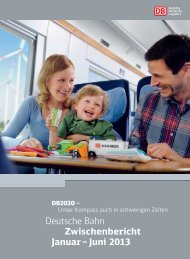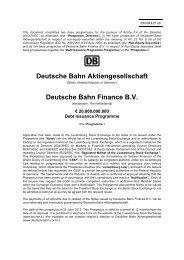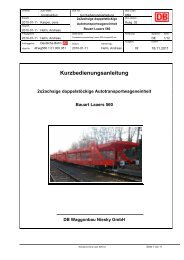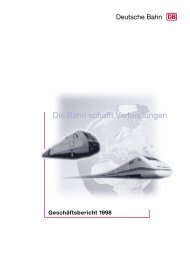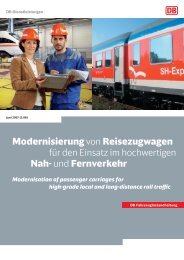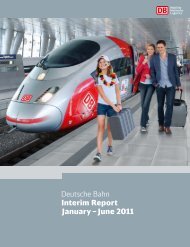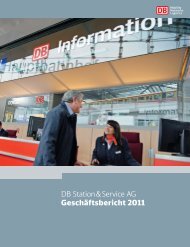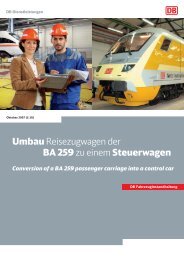PDF Download - Deutsche Bahn AG
PDF Download - Deutsche Bahn AG
PDF Download - Deutsche Bahn AG
Create successful ePaper yourself
Turn your PDF publications into a flip-book with our unique Google optimized e-Paper software.
|<br />
mAN<strong>AG</strong>EmENT rEPOrT<br />
implementation of the regulation, which they would like to approve<br />
in the first quarter 2011. DB Netz <strong>AG</strong> is intensively working on<br />
ways to limit the negative effects of the regulation on operations.<br />
EU COMMISSION PREPARING TRANSPORT POLICY<br />
STRATEGY THROUGH TO 2020<br />
The EU Commission plans to submit a new White Book during<br />
the first half of 2011 wherein they define their transport policy<br />
through to the year 2020. We welcome the main points of the<br />
content that have emerged thus far. Along with the integration<br />
of transport modes and networks – including greater inclusion<br />
of rail – the main topics are climate protection, more efficient<br />
use of energy, and promoting competition by reducing regulatory,<br />
administrative and technical barriers. In addition, the<br />
Commission also addresses different financing models for the<br />
transport sector, and the internalization of external costs.<br />
NEW TRANS-EUROPEAN TRANSPORT<br />
NETWORk GUIDELINES<br />
The EU Commission has initiated a fundamentally new approach<br />
to its previous policy concerning the development of a trans-<br />
European transport network (TEN-V). Plans call for new directives<br />
to be published in the first half of 2011 wherein the TEN-V and<br />
the selection criteria for projects will be recast. The intention<br />
is to achieve better integration of all modes of transport through<br />
DeveLopMentS in tHe reLevant MarKetS<br />
Passenger transport<br />
GERMAN PASSENGER TRANSPORT MARkET<br />
means such as the inclusion of intermodal interfaces (e.g. harbors,<br />
airports), new principles regarding targeted use of EU<br />
subsidies, and a stronger focus on a so-called core network,<br />
which still needs to be redefined.<br />
STRUCTURING EMISSIONS TRADING AS OF 2013<br />
The amended version (2009/29/EC) of Directive 2003/87/EC<br />
regarding the trading of emissions rights took effect in may<br />
2009. Per the terms of the new directive the energy industry<br />
will have to obtain all of their certificates via auction as of<br />
2013. In addition to the current burden facing electrically<br />
powered rail transport, this complete auction process means<br />
that the cost burden arising from trading carbon dioxide (CO2)<br />
emissions allowances will rise further as of 2013. This will lead<br />
to another substantial increase in the price of traction current.<br />
Other modes of transport are unaffected, or only marginally<br />
affected by CO2 emissions trading: road transport and shipping<br />
are still not subject to CO2 emissions trading despite the fact<br />
that they also emit CO2. Per the terms of Directive 2008/101 /<br />
EC, only air transport within the EU, as well as to and from<br />
Europe, will be included in CO2 emissions trading as of 2012,<br />
however this segment will only have to obtain 15 % of its<br />
CO2 certificates via auction.<br />
German passenger transport market [ % based on volume sold ] Growth rates Market share<br />
2010 2009 2010 2009<br />
Rail passenger transport +2.4 –1.5 10.1 9.8<br />
DB Group +2.2 –1.6 9.4 9.2<br />
Non-Group railways + 5.0 + 0.3 0.7 0.7<br />
Public road passenger transport – 0.5 – 1.0 9.5 9.6<br />
DB Group – 0.5 + 0.7 1.1 1.1<br />
Motorized individual transport 0.0 0.0 79.1 79.3<br />
Air transport (domestic) +2.2 – 3.6 1.3 1.3<br />
total market + 0.2 – 0.3 100.0 100.0<br />
Data for 2009/2010 is based on information and estimates available on February 22, 2011.<br />
The total German passenger transport market recorded a slight<br />
gain in volume sold in 2010 thereby connecting to the robust<br />
development noted in 2009.<br />
While the rise in demand noted in the rail passenger and in<br />
domestic air transport sectors was driven by favorable overall<br />
economic conditions in Germany coupled with gains in both<br />
employment figures and disposable real income levels, the public<br />
11



